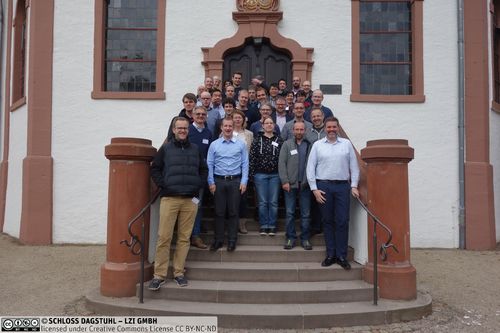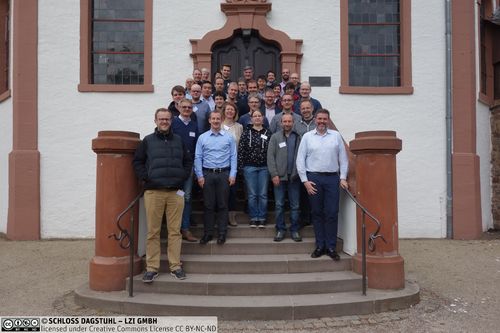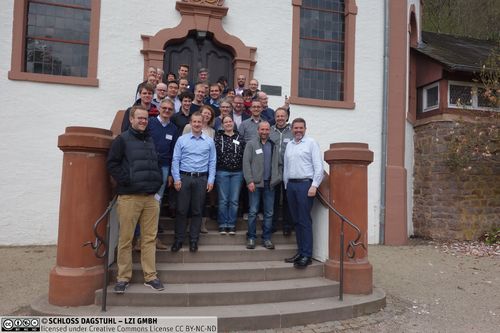Dagstuhl Seminar 17161
Ambient Notification Environments
( Apr 17 – Apr 20, 2017 )
Permalink
Organizers
- Lewis Chuang (MPI für biologische Kybernetik - Tübingen, DE)
- Sven Gehring (DFKI - Saarbrücken, DE)
- Judy Kay (The University of Sydney, AU)
- Albrecht Schmidt (Universität Stuttgart, DE)
Contact
- Jutka Gasiorowski (for administrative matters)
Impacts
- A Survey of Attention Management Systems in Ubiquitous Computing Environments : Article No. 58 in Proceedings of the ACM on Interactive, Mobile, Wearable and Ubiquitous Technologies, IMWUT - Anderson, Christoph; Hübener, Isabel; Seipp, Ann-Kathrin; Ohly, Sandra; Pejovic, Veljko; David, Klaus - New York : ACM, 2018. - 27 pp..
- Feel the Movement : Real Motion Influences Responses to Take-over Requests in Highly Automated Vehicles : article No. 246 in CHI '18 Proceedings of the 2018 CHI Conference on Human Factors in Computing Systems - Boll, Susanne; Heuten, Wilko; Bülthoff, Heinrich H.; Chuang, Lewis L. - New York : ACM, 2018. - 13 pp..
- Understanding systems that are designed to support human cognition : article : Rethinking Interaction - CHI 2018 workshop - Chuang, Lewis L.; Schmidt, Albrecht - exSitu, 2018. - 5 pp..
Users of digital devices are increasingly confronted with a tremendous amount of notifications that appear on multiple modalities in their environment. This Dagstuhl Seminar brings together researchers and practitioners from academy and industry to explore how the flood of notifications on different computing devices and in smart environments can be managed, in order to avoid information overload. Ambient notifications have the potential to support people in their daily activities, providing courses of action and relevant information in context. A key aspect of ambient notification is the unobtrusive provision of information, embedded into a user’s environment. With the tremendous number of services providing notifications on numerous devices, it is important that the various communities communicate to exploit synergies and to create unobtrusive notification environments avoiding redundancy. The seminar will consider key areas related to next-generation ambient notification environments including:
- Designing and Embedding Notifications
- Smart Notification Management
- Implementing Notifications
- Psychology of Perception
To communicate options for the current action within a given context, ambient notifications must be unobtrusive and relevant to the user. Thus, research questions to be pursued during the seminar include:
- Understanding behavior and habits around notifications
- Detection/prediction of availability, attention, and opportune moments for interruptions
- Ambient, peripheral, distributed and multimodal presentation of interruptions
- Ambient notification technologies
- Timing of pro-active recommendations and user engagements
- Infrastructures, frameworks and tools for the development of smart attention systems
- Integrating notifications unobtrusively into a home environment
- Deducing plans and activities, detecting interruptions and providing action alternatives
We are planning to publish the outcome of the seminar either in conference proceedings (such as ACM CHI 2018) or as one of the very first interdisciplinary books on ambient notification environments, focusing on key aspects of cognitive psychology and human-computer-interaction.
This Dagstuhl Seminar presents a unique and exciting opportunity to bring together representatives from these fields with the explicit aim of advancing the state of the art in ambient notification environments. We expect the seminar to help initiate international collaborative research and deployments and to begin to define the shape of these kinds of systems. There will be plenty of opportunities for participants to present and discuss their own work as well as engaging in discussions. We believe that the seminar has the potential to be noted as the start of new ideas in an area with great potential and impact in academia, industry, and everyday life and we look forward to an exciting and challenging event.
 Lewis Chuang, Sven Gehring, Judy Kay, Patrick Olivier, and Albrecht Schmidt
Lewis Chuang, Sven Gehring, Judy Kay, Patrick Olivier, and Albrecht Schmidt
Reports indicate that many users interact with their smartphone and wearable devices more than 100 times per day. Oftentimes, these interactions result from direct notifications, presented on the screen or via sounds. New communication applications (e.g. from email to WhatsApp) has increased the frequency of notifications, while social media applications are inherently motivated to entice repeat visits and interactions. The end result is that more and more systems as well as applications compete for the user’s attention using notifications. Projecting this into the future, it is apparent that current implementation schemes that rely on direct notifications will not scale. A simple extrapolation of the rate in notifications suggests that a near future whereby users will only attend to notifications with no time leftover for productive work. Therefore, a radical restructure of notification delivery is necessary - specifically, one that keeps the user in-the-loop without consuming all of the user’s attention. This is a key challenge. If no alternatives to direct notifications can be realized, current visions of ubiquitous computing and smart environments are likely to be unrealistic, given their anticipated undesirability to the end-user. In the Dagstuhl Seminar 17161 "Ambient Notification Environments", we looked at how novel approaches to notification delivery can address the above issue. We brought together researchers and experts that understand the technical, psychological, and social aspects of notification systems. This facilitated a broad discussion that was fuelled by the discussants’ joint expertise in mobile and smart home technologies, in ambient sensing and presentation, and psychological models of human attention, to name a few. This discussion brought to the foreground, many of the underlying challenges that deserves further research. On the hand, a technological push in novel communication and smart devices drives an immediacy in user interaction. On the other hand, this will result in a higher demand on human attention. In the current report, we document the diverse approaches that were proposed as an alternative means towards notifications that are more personalized and contextualized, with the express purpose of reducing user effort. The central aim of the seminar was to understand the challenges and questions that we face when designing future interactive systems and to overcome the mounting notification problem. In addition to the ideas raised in the individual presentations and the group sessions, we jointly identified the following research questions and challenges:
- How can notifications be designed to be simultaneously non-intrusive and yet noticeable?
- How can artificial intelligence be designed to provide effective context-aware notifications?
- What is a suitable notification architecture for integrating user devices, smart (shared) environments, and personal data without compromising personal privacy?
- What is a suitable conceptualization for notification systems and how will a taxonomy for classifying notification delivery that is centered on user preferences and privacy look like?
Overall, the seminar contributed to a common vision of how interactions between human and systems can and ought to progress - one where technological progress does not necessitate an ever growing burden on the user’s attention. In this report, we balance an analysis of the underlying drivers and problems, ideas for novel conceptual and technical approach, and most importantly a set of questions and research challenges in this domain that merit the attention of like-minded researchers.
 Albrecht Schmidt
Albrecht Schmidt
- Elisabeth André (Universität Augsburg, DE) [dblp]
- Susanne Boll (Universität Oldenburg, DE) [dblp]
- Stephen Brewster (University of Glasgow, GB) [dblp]
- Barry Brown (Stockholm University, SE) [dblp]
- Andreas Bulling (MPI für Informatik - Saarbrücken, DE) [dblp]
- Andreas Butz (LMU München, DE) [dblp]
- Keith Cheverst (Lancaster University, GB) [dblp]
- Lewis Chuang (MPI für biologische Kybernetik - Tübingen, DE) [dblp]
- Raimund Dachselt (TU Dresden, DE) [dblp]
- Anind K. Dey (Carnegie Mellon University - Pittsburgh, US) [dblp]
- David Dobbelstein (Universität Ulm, DE) [dblp]
- Christoph Gebhardt (ETH Zürich, CH) [dblp]
- Sven Gehring (DFKI - Saarbrücken, DE) [dblp]
- Hans Gellersen (Lancaster University, GB) [dblp]
- Tom Gross (Universität Bamberg, DE) [dblp]
- Niels Henze (Universität Stuttgart, DE) [dblp]
- Judy Kay (The University of Sydney, AU) [dblp]
- Pascal Knierim (Universität Stuttgart, DE) [dblp]
- Thomas Kosch (Universität Stuttgart, DE) [dblp]
- Bob Kummerfeld (The University of Sydney, AU) [dblp]
- Markus Löchtefeld (Aalborg University, DK) [dblp]
- Evangelos Niforatos (University of Lugano, CH) [dblp]
- Tadashi Okoshi (Keio University - Fujisawa, JP) [dblp]
- Joseph A. Paradiso (MIT - Cambridge, US) [dblp]
- Veljko Pejovic (University of Ljubljana, SI) [dblp]
- Benjamin Poppinga (AUDI AG - Ingolstadt, DE) [dblp]
- Aaron Quigley (University of St. Andrews, GB) [dblp]
- Harald Reiterer (Universität Konstanz, DE) [dblp]
- Michael Rohs (Universität Hannover, DE) [dblp]
- Albrecht Schmidt (Universität Stuttgart, DE) [dblp]
- Aurélien Tabard (University Claude Bernard - Lyon, FR) [dblp]
- Pauline Vierne (Universität der Künste - Berlin, DE) [dblp]
- Alexandra Voit (Universität Stuttgart, DE) [dblp]
- Frederik Wiehr (DFKI - Saarbrücken, DE) [dblp]
Classification
- mobile computing
- society / human-computer interaction
Keywords
- Ambient Notification
- Notification Management
- Context Recognition
- Activity Recognition
- Ubiquitous Computing




 Creative Commons BY 3.0 DE
Creative Commons BY 3.0 DE
